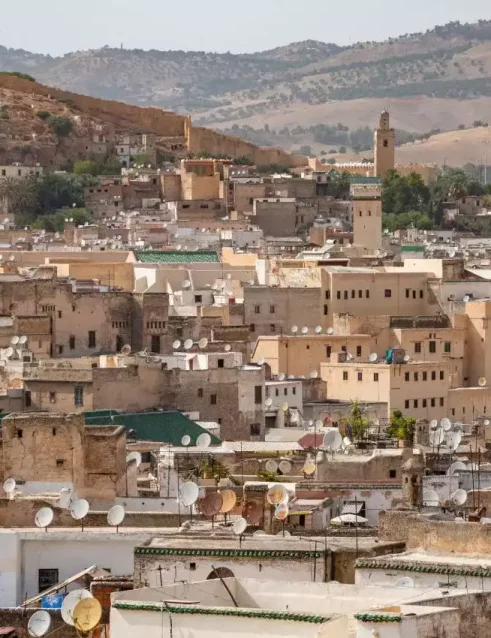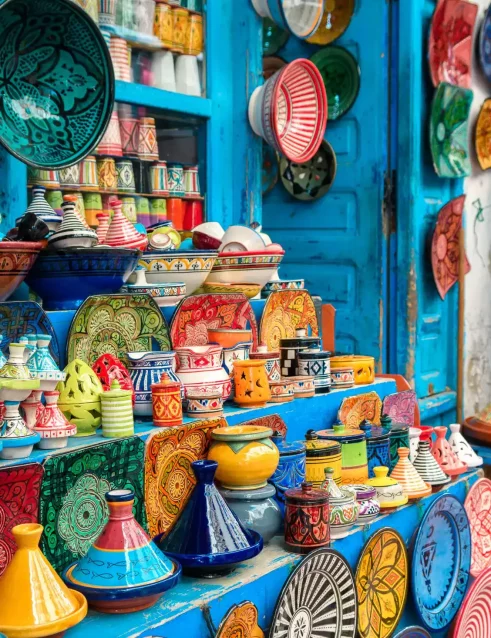Ait Ben Haddou

The ksar of Aït Benhaddou represents not only a key piece of Moroccan heritage but also a living community. While many residents have relocated to more modern towns, a handful of families continue to reside within the ancient granaries and merchant houses, maintaining their traditional way of life amidst the structures that have withstood the test of time. The labyrinthine alleys and ornate carvings in the buildings stand as a testament to the skilled craft that has been passed down through generations, capturing the essence of Morocco’s rich history.
Aside from its historical and architectural significance, Aït Benhaddou has also captured the imagination of filmmakers around the world. It has been the backdrop for numerous film productions, including Lawrence of Arabia and Game of Thrones, which have made use of its timeless and dramatic landscape. This blend of cultural heritage and cinematic fame makes Aït Benhaddou more than just an architectural wonder; it is a bridge between the past and the present, inviting both scholars and tourists alike to explore its enduring legacy.
History of Ait Benhaddou
Ait Benhaddou is located along an ancient caravan route that once served as a critical link between the Sahara and Marrakesh. This fortified village, or ksar, sits in the Ounila Valley in Morocco and is an outstanding example of Southern Moroccan architecture. The strategic importance of this location is highlighted by its role in facilitating the exchange of goods and cultures across the desert.
The origins of Ait Benhaddou can be traced back to at least the 11th century, during the Almoravid period. Structures that we see today largely date from the 17th century and reflect earthen construction techniques typical of Moroccan architecture in pre-Saharan regions. Its high mud-brick walls and imposing defensive towers showcase the ingenuity of its ancient inhabitants in adapting to their environment.
Recognized as a UNESCO World Heritage Site, Ait Benhaddou has been preserved as an example of early human settlement in North Africa. The site has also found fame in modern times as a filming location for many notable movies, which has led to an increased awareness and appreciation of its cultural and historical significance.
The architecture of Ait Benhaddou illustrates the main types of earthen constructions that are characteristic of the region. Its layout consists of various dwellings, some modest, others resembling small urban castles with their high angle towers and upper sections, all connected within a defensive wall reinforced by angle towers and pierced by a baffle gate.
Architecture and Design
The Kasbah of Ait Benhaddou stands as a testament to traditional Moroccan earthen clay architecture, reflecting the ingenuity and cultural heritage of the region.

Kasbah Construction
The construction of Ait Benhaddou’s Kasbah utilizes adobe, a material composed of earth mixed with water and organic materials such as straw. This ancient technique creates thick walls that are ideal for the hot climate, as they provide insulation against the heat. Buildings are strategically clustered together, which further enhances the defensive nature of the ksar and adapts to the landscape’s contours for stability.
Defensive Features
Defensive characteristics are integral to the Kasbah’s design, indicative of a time when protection was a paramount concern. The collective arrangement of buildings, with limited points of entry and narrow, winding streets, contributes to its defensibility. Defensive towers called marabouts once surveyed the surroundings, and high, imposing walls guarded the inhabitants against potential invasions.
Cultural Significance
Aït Benhaddou is not only a historic site but also a cultural emblem, known for its earthen clay architecture and symbolic motifs with significant heritage value.
UNESCO World Heritage Site
Aït Benhaddou has been recognized as a UNESCO World Heritage Site since 1987. The ksar (fortified village) represents traditional Saharan habitat with houses made from local organic materials huddled within defensive walls. This recognition underscores its value as an important cultural site that reflects the ingenuity of past local communities in adapting to their environment.
Cinema and Television
The ksar’s timeless appearance and preservation state have made it a sought-after location for film and television productions. Aït Benhaddou gained international fame for its appearance in the acclaimed TV series Game of Thrones, showcasing Moroccan architecture to audiences worldwide. Its use in cinema contributes to its cultural significance as a living set that continues to captivate and inspire storytellers.

Tourism in Ait Benhaddou
Ait Benhaddou is a striking example of Southern Moroccan architecture and a significant destination for travelers seeking to explore an authentic Kasbah and immerse themselves in the traditional culture and flavors of the region.
Visiting the Kasbah
The Kasbah of Ait Benhaddou is a UNESCO World Heritage Site that stands as an extraordinary fortress exemplifying the traditional earthen clay architecture. Visitors can explore the alleys and climb to the high points for panoramic views of the surrounding Ouarzazate area, often referred to as the Hollywood of North Africa due to its popularity as a filming location. Access to the site is usually through a guided tour, which provides insightful historical information and points out the architectural features of this ancient town.
Local Customs and Cuisine
Travelers to Ait Benhaddou are encouraged to interact with local customs and sample the regional cuisine, which includes tagine, a slow-cooked stew. This dish, as well as others like couscous, may be enjoyed in smaller, family-run eateries that provide an authentic dining experience. It’s important to show respect for local traditions and dress modestly when exploring, as it is a reflection of cultural sensitivity. Visitors may find themselves welcomed with a glass of mint tea, a gesture of hospitality in Morocco.
Conservation Efforts
The Ksar of Ait-Ben-Haddou represents a quintessential example of preserved Moroccan architecture, prompting concerted conservation efforts to maintain its integrity. Recognizing its cultural significance, UNESCO has inscribed the site on the World Heritage list, providing a framework for its ongoing protection.
A robust management plan ranging from 2020 to 2030 illustrates the dedication to preserving Ait-Ben-Haddou’s cultural heritage. This plan includes measures to protect the physical structures as well as the intangible elements that convey the ksar’s historical significance.
Key conservational strategies:
- Structural stabilization of the earthen architecture against environmental wear
- Education and involvement of the local community in site preservation practices
- Sustainable tourism management to balance visitor experiences with conservation needs
The ksar’s conservation utilizes traditional techniques and materials, ensuring that maintenance aligns with its original construction methods. This approach not only reinforces the site’s historical authenticity but also supports the local economy by employing native artisans and craftsmen.

The collaboration between international organizations, national government bodies, and local stakeholders underscores the global importance of safeguarding such a significant historical landmark. The work done at the Ksar of Ait-Ben-Haddou serves as a standard for other conservation initiatives within Morocco and beyond.
Frequently Asked Questions
This section provides clear answers to common inquiries about Ait Ben Haddou, offering insights into its historical significance, conservation efforts, visitor access, and cultural impact.
What is Ait Ben Haddou known for?
Ait Ben Haddou is renowned as a striking example of Moroccan earthen clay architecture and for its role as a filming location for movies such as “Lawrence of Arabia” and “Gladiator.” This ancient ksar has been a UNESCO World Heritage Site since 1987, showcasing intricate designs and the history of the region.
How has Ait Ben Haddou been preserved in the face of natural disasters such as earthquakes?
Conservation efforts at Ait Ben Haddou have focused on reinforcing structures using traditional materials and methods. These practices ensure that the site maintains its historical integrity while enhancing its resilience against natural forces.
Can visitors explore the interior of the Kasbah of Ait Ben Haddou?
Yes, visitors can explore the interior of the Kasbah. The site remains open for tourism, allowing individuals to experience the architectural beauty and ambiance of the ksar firsthand.
How old is Ait Ben Haddou?
The oldest parts of Ait Ben Haddou are believed to date back to the 17th century. This makes it a significant historical site that has witnessed numerous caravans and traders passing through the Ounila Valley over centuries.
Are there any residents in Ait Ben Haddou, and what is the local lifestyle like?
A small number of residents still live in Ait Ben Haddou. They maintain a traditional lifestyle that is closely tied to the ksar’s heritage, engaging in local crafts and tourism-related activities.
How does Ait Ben Haddou contribute to the cultural heritage of Morocco?
Ait Ben Haddou contributes significantly to Morocco’s cultural heritage by encapsulating the traditional ways of ksar construction, providing a window into the past, and representing the Amazigh (Berber) cultural landscape. It continues to be a symbol of Moroccan history and architecture, attracting visitors from around the world.









